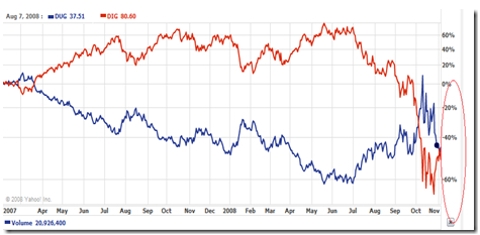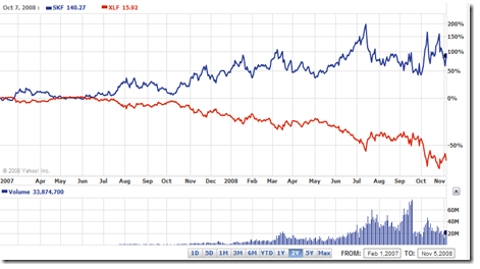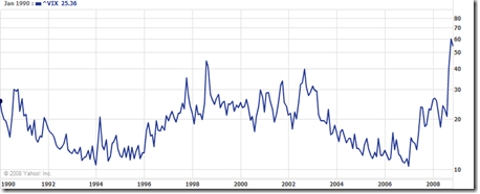日前在某討論區看到一篇介紹反向及槓桿型 ETF 的文章, 內容堪稱深入淺出, 經作者同意後翻譯登出, 並附上原文及連結於後.
Suppose you believe that the market is going to go down, what would you do? The normal answer is sell what you have and get out. However, what if you have nothing to sell? Until a couple of years ago, the answer would have been "Stay on the sidelines" for simple investors. The sophisticated investors always had plenty of avenues - shorting the stock, buying puts, selling naked calls, etc.
如果你相信市場即將要向下走, 你會怎麼作? 一般普通人的答案是把你手中有的全部賣掉, 然後離開市場. 然而, 如果你手上根本就沒東西可以賣呢? 相對於其他精明的投資人總是有各種方法, 如做空股票,買"賣權", 賣 "買權" 等... 直到幾年前, 普通的投資人只能當個局外人.
However, the gap was narrowed with the arrival of Inverse ETFs that allow even novice investors to short the market in a less risky way (you cannot lose more than what you put in the ETF, while in shorts your loss is theoretically unlimited and this can be psychologically unsettling for some). However, the power and pitfalls of these instruments are poorly understood by many, particularly by the long term investors. The power is obvious - you can go 1/X or 2/X of the market pretty easily, leaving all the pesky details of achieving them to the ETF managers. Here are the pitfalls.
然而, 這個差距在反向 ETF 出現之後被縮小了, 就算是剛入門的投資者也可以用一種較低風險的方式來作空. (最多就損失你投入 ETF 的錢, 而普通作空的方式理論上的損失是無限制的, 後者在心理上會使某些人感到不安). 不過呢, 這些工具的能力跟陷阱並不為大多數人所清楚了解, 特別是對於長期投資者. 他們的能力是很明顯的, 你可以很輕易的往市場的反向 (1倍或是 2倍) 走, 並把那些惱人的細節都留給 ETF 的經理人. 接下來的是陷阱!
1. Inverse and Leveraged ETFs lose money over the long term
Here is the chart from Yahoo Finance of DUG (Double inverse of petroleum companies) and DIG (Goes 2X in the direction of petroleum companies). Basically they are the yin and yang of Oil industry. Regardless of what happens in the market surely one of them must win, right? But, look deeply at the cart - both of these funds lost 45% in the last 20 months.
1. 長期來看, 反向或是槓桿 ETF 都會虧損
底下是從 Yahoo Finance 所取的 DUG (石油公司的雙倍反向ETF) 與 DIG (雙倍作多石油公司) 的圖. 基本上他們是石油產業的 陰 與 陽. 無論市場發生什麼事, 總會有一方獲勝, 不是嗎? 但是, 仔細看一下這個圖, 這兩檔基金都分別賠了 45% 在最近的 20 個月之內.
所以, 就算你能夠預測市場正確的方向, 你還是會在一年半之內輸掉一半的錢...
So, even if you had predicted the correct direction, you would have lost half your money in just 1.5 years.
2. Inverse ETFs can track the underlying for only one time period
Mathematically, leveraged and inverse ETFs can track their underlying index exactly for one time period only. If they track their index accurately for hourly, then it can't track for daily, weekly, monthly and so on. This is due to the way compounding works. Let us say your underlying went 1% down everyday for 1 month. The underlying will go down 26% [(1-0.01)^30], while your inverse would have gone up 35% [(1+0.01)^30]. Most inverse funds plan to track daily, so for other time periods you will see an error.
2. 反向 ETFs 只能在一段時間內緊貼相關指數
從數學上來說, 槓桿跟反向 ETF 只能夠在一段時間內完全的追蹤其相關指數. 如果他們準確的追蹤指數每個小時的表現, 則不能適用於每天, 每週, 每個月的指數表現. 這是因為複合增長的關係. 舉例來說, 如果你的相關指數每天跌 1% 跌一個月, 則一個月後總共跌了 26% [(1-0.01)^30], 同時你的反向基金則會上漲 35% [(1+0.01)^30]. 大部份的反向基金都是追蹤每天的表現, 所以在其他的時間區間下, 誤差就會產生.
3. Tracking error increases with time
Here is the comparison chart between XLF (Financial Sector Index) and its double Inverse SKF. SKF is supposed to go 2X in the opposite direction of XLF, and though it was good in maintaining the direction, it was not very good in exact tracking. XLF fell 62% in the period from February 2007, while SKF has gone up only 90%, instead of 124% as would have been expected.
3. 追蹤誤差隨著時間而增加
這裡有一張比較 XLF (金融指數) 跟它的雙倍反向 SKF 的比較圖. SKF 應該是往 XLF 的兩倍反向走, 儘管這次方向是對了, 但是卻沒能完全的追蹤. XLF 從 2007 年二月開始跌了 62% , 同時 SKF 只有上漲 90%, 離預期的 124% 還有一段距離.
4. Degenerative decay and relationship to volatility
Leveraged ETFs' efficiency goes down with volatility. The problem is even more so with inverse ETFs. Let us say the Dow went from 10K to 8K and back to 10K. An inverse ETF tracking accurately will go up from 100 to 120 (20% gain to equal 20% loss in Dow) and then from 120 to 90 (25% loss because Dow gained 25%). So, from period t1 to t2, the Dow stayed the same, while its inverse ETF fell by 10% from 100 to 90. Repeat the same process x number of times, and you will find the inverse ETFs totally wiped out of the value, while underlying has not moved much. If the Dow goes up to 10000 from 9900 and back to 10000, the inverse would be reasonably accurate. However, we are at a historically high volatility - the highest in the last 20 years. Here is the movement of volatility Index [VIX] over the last 18 years.
4. 變質的衰退與跟市場波動的關連
槓桿ETF 的效率會隨著市場波動程度變大而變差. 反向的 ETF 問題甚至更加嚴重. 舉例來說, 當道瓊指數從 一萬點跌到八千點, 然後再漲回一萬點. 反向的 ETF 精準的追蹤指數的話會從 100 漲到 120 (漲 20%, 道瓊跌 20%) 然後再從 120 跌到 90 ( 跌 25%, 因為道瓊漲了 25%). 因此我們可以發現, 當時間從 t1 到 t2 , 道瓊指數不變, 然而反向 ETF 卻跌了 10% 從 100 跌到 90. 當同樣的程序不斷重複 x 次, 你會發現反向 ETF 的價值全部消失而相關指數則沒有改變多少. 一般來說如果道瓊指數從 10000跌到 9900 再漲回 10000, 基本上反向ETF 大致還是精準的. 但是我們現在處在歷史紀錄的高波動市場中, 是過去 20 年以來最高的. 上面是過去 18 年以來的波動指數[VIX] 走勢
5. Constant Leverage Trap
Constant Leverage Trap is a well know problem in financial modeling and affects the performance of inverse ETFs. Here is a simple scenario explained by Tyates in a financial forum:
5. 持續的槓桿陷阱
持續的槓桿陷阱是金融模型上一個廣為人知的問題, 它也影響反向 ETF 的表現. 底下是 Tyates 在一個金融論壇上提出的一個簡單劇本.
Proshares has $1m of investor money and borrows $1m of additional money to invest $2m in the S&P 500 index. After six months, the index appreciates 10%, and then the fund has $2.2m in assets and $1.2m of equity. (Let's ignore interest on debt for now).
Proshares (著名的這類ETF 的發行公司) 有 一百萬 投資人的錢, 然後他再去借 一百萬總共投資在 S&P 500 指數. 六個月後, 指數增值了 10%, 則此時基金有 兩百二十萬的資產, 淨值則有一百二十萬. (暫且先省略負債的利息)
The problem is that the fund now has a lower debt to equity ratio than advertised. It is supposed to be a 2x fund, but now only has $1m of debt paired with its $1.2m of equity, making it a 1.67x fund. In order to get back to its target leverage it has to borrow $200,000 and invest in the index. Now the fund has $2.4m in assets and $1.2m in debt. Six more months go by, and the index falls 10%. The fund now has $2.16m in assets and $1.2m in debt, leaving the investors with $960k in equity. This 4% loss surprises investors who thought that the index was down 1% for the year (+10% and -10% = -1%).
問題是, 現在基金的負債淨值比例已經低於它所公佈的. 它應該是一個兩倍的基金, 現在它有一百萬的債配上一百二十萬的淨值, 使得它成為一個 1.67 倍的基金. 為了要能夠變回原先的兩倍槓桿, 它必須再借 20 萬的錢再投入到該指數中. 現在基金 有 兩百四十萬的資產及一百二十萬的負債. 又過了六個月, 該指數跌了 10%. 這時基金現有兩百一十六萬的資產, 還有一百二十萬的負債, 淨值是九十六萬. 投資人可能會被 4% 的虧損嚇到, 明明指數一整年不過跌 1% (漲10% 再跌 10% = 跌 1%)
But what happens next is even worse. Because the leverage ratio is out of balance again - total assets are 2.25x the equity, not 2x - the fund has to sell its shares in order to reduce its leverage back down to 2x. It sells $240k worth of shares, and applies all of this cash to reducing the debt to $960k. The fund is now smaller than when it started. Yes, you read that correctly, to maintain constant leverage, this index fund is constantly buying and selling, incurring short-term gains, and doing the worst possible market timing - buying more on margin when prices are high and selling when they're lower.
6. Regulatory Actions:
When the SEC comes up with a short ban as it did in September, it can substantially screw up the market. For a couple of weeks SKF was affected due to its inability to find appropriate counterparties for its trade. Typically, governments tend to go more after bears than bulls in a mistaken fear that bears are causing the problems instead of being the messenger of problem information. Thus regulatory actions can be more unfavorable to bearish strategies than bullish strategies.
http://biz.yahoo.com/ms/
6. 調控行為
當 SEC 在九月份時提出要禁止放空時, 這項措施大大的搞砸了這個市場. 有好幾個星期 SKF 的表現因為不能找到適當的交易對手而受到很大的影響. 一般說來, 政府傾向追殺熊更甚於牛, 基於一種誤解的恐懼, 怕熊會製造麻煩而不把牠當成是問題資訊的使差. 因此, 調節行為對於熊市策略來講更不被喜好.
7. Counterparty risk
Inverse ETFs achieve their strategies through swaps and futures contracts with various counterparties. There are troubles when the counterparties don't honor their contract. When these parties fail, then the ETF could lose money.
Here is some good information on this, written by Paul Amery.
7. 交易對手風險
反向ETF 透過掉期交易及與各路人馬的期貨合約來達到它的策略目的. 所以當交易對手不履行合約的話, 就會有麻煩了.
8. Other factors to consider
- Can you stomach the volatility? Double Inverse and Leverage ETFs tend to move enormously by definition, particularly in troubled times like these - you could see your portfolio going up or down 50 or 75% - even if it too heavily weighted in such ETFs. Will you have trouble sleeping well in such roller coaster activity? If so, you should not play.
- High Management Expense - given that these ETFs are not plain vanilla - buy a bunch of stock types, management expenses of maintaining leverage is pretty high. Sometimes the expense ratios can be up to 5X more than popular index ETFs.
8. 其它要考慮的因素
你能受得了市場波動嗎? 雙倍反向跟槓桿 ETF 從定義上來看傾向更劇烈的波動, 特別是像最近的情況. 你可能會看到你的投資組合上下 50% 甚至 75% . 你如果會因此而睡不好的話, 最好別玩. 另外這類的 ETF 的管理費也遠較其它單純的指數 ETF 來得高, 甚至可達 5倍之多.
Summary:
Inverse and leveraged ETFs are great tools that democratized bear strategies. However it should not be used for anything other than short term trading purposes. And when you use it, understand its risks and don't be surprised when you find the results are not as promised.
總結
反向跟槓桿 ETF 是很棒的工具使得熊市策略更加大眾化. 然而它不應該用來做除了 "短期交易" 以外的用途. 如果你用了它, 請了解它的風險, 並且當你發現結果不像它所承諾時, 不要太過驚訝嘿~



沒有留言:
張貼留言